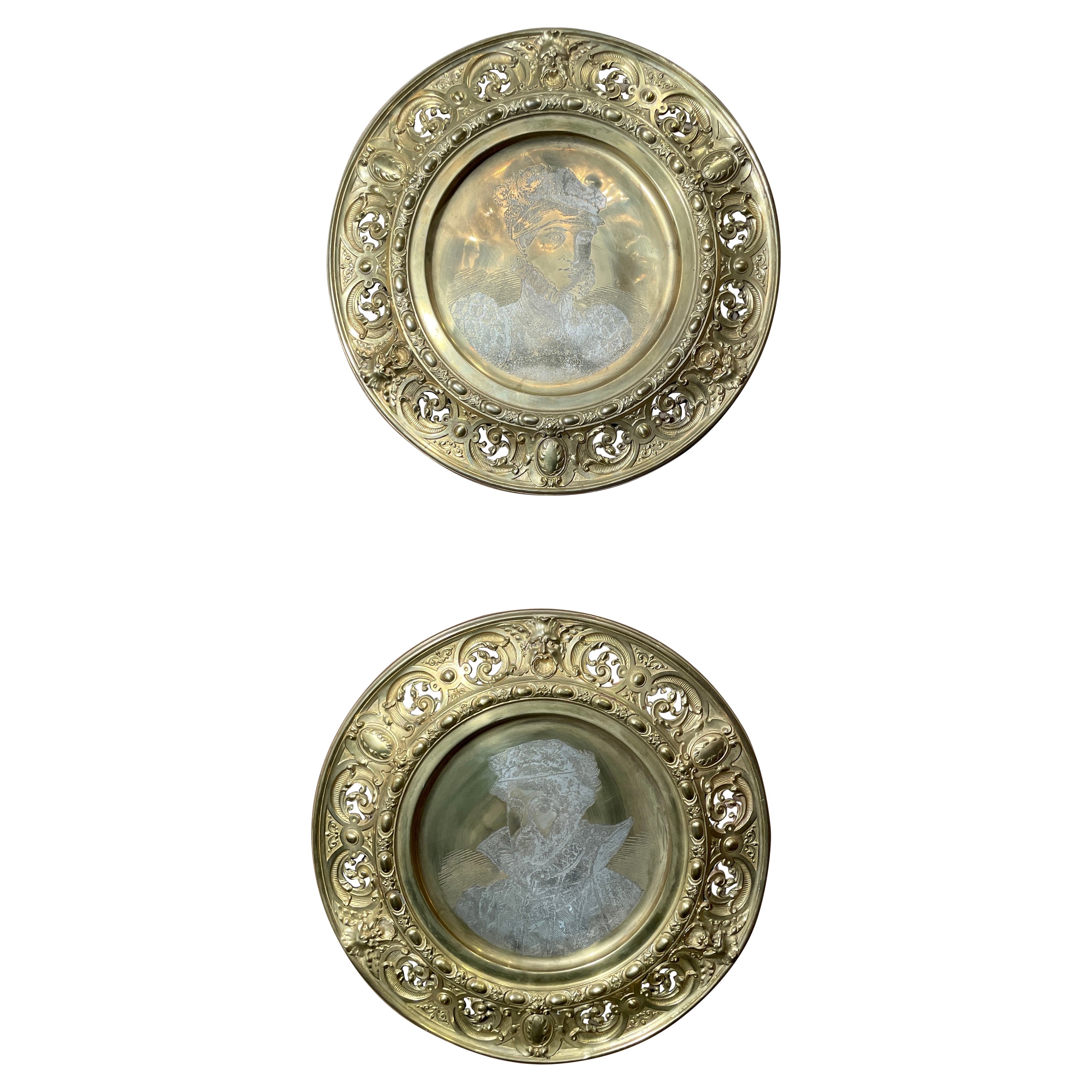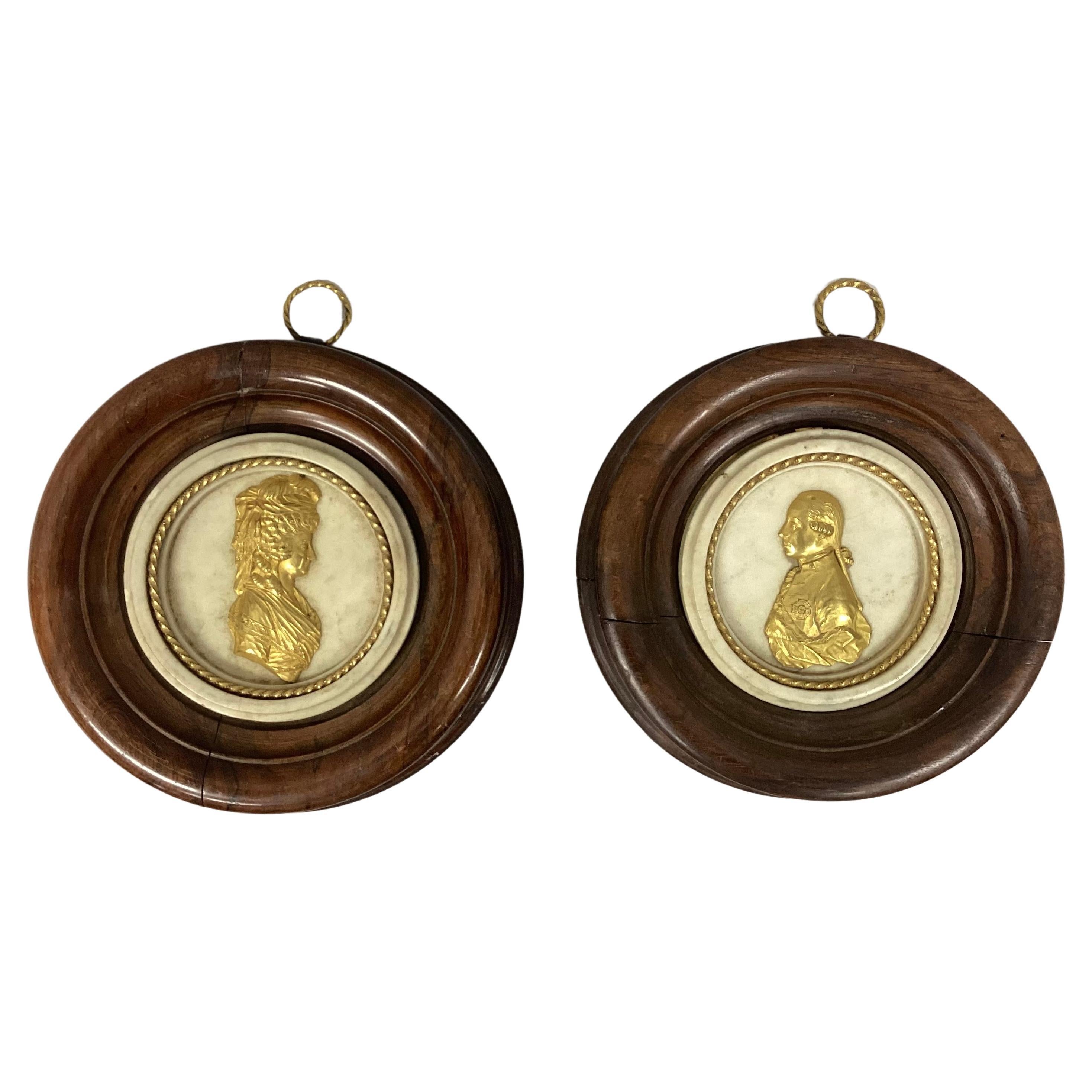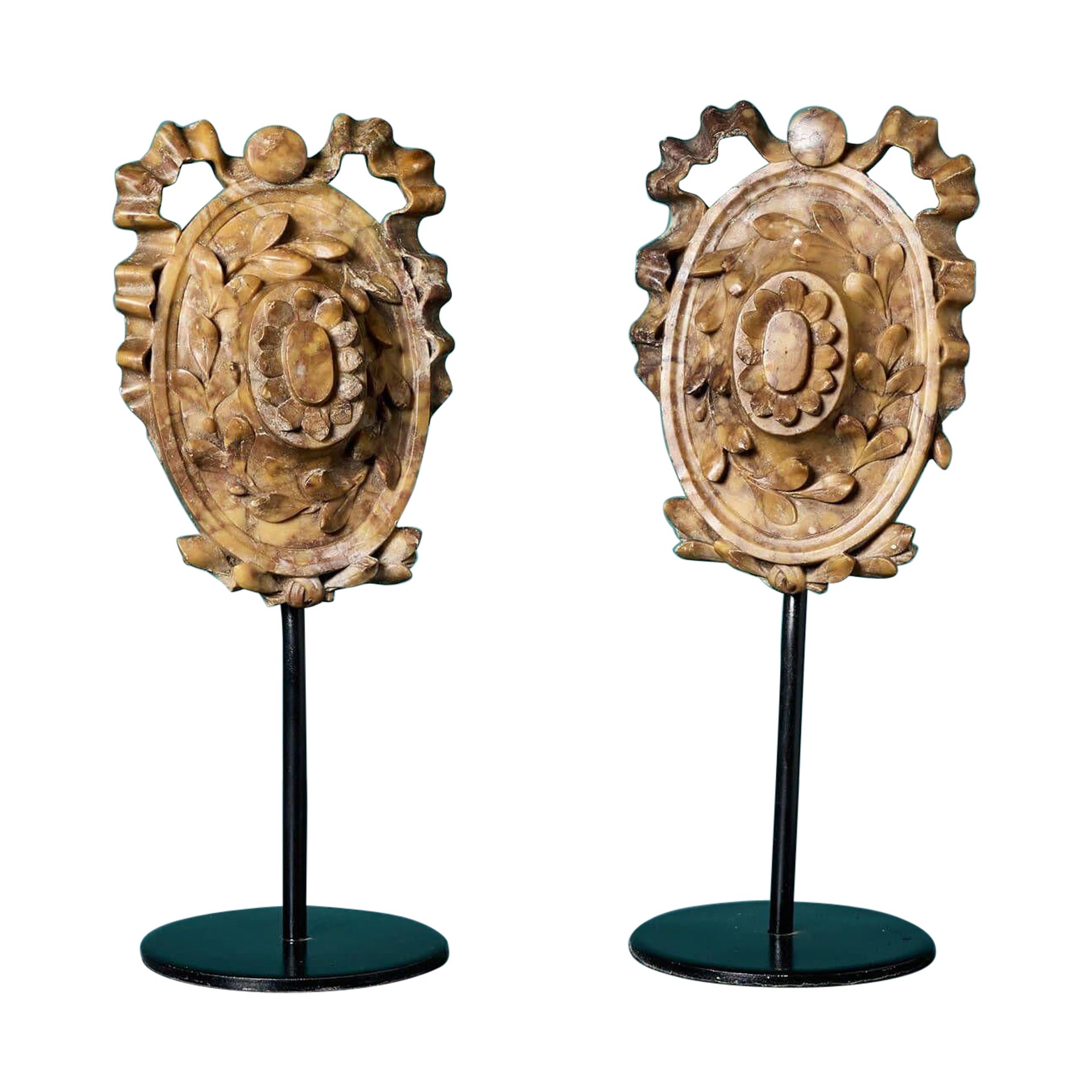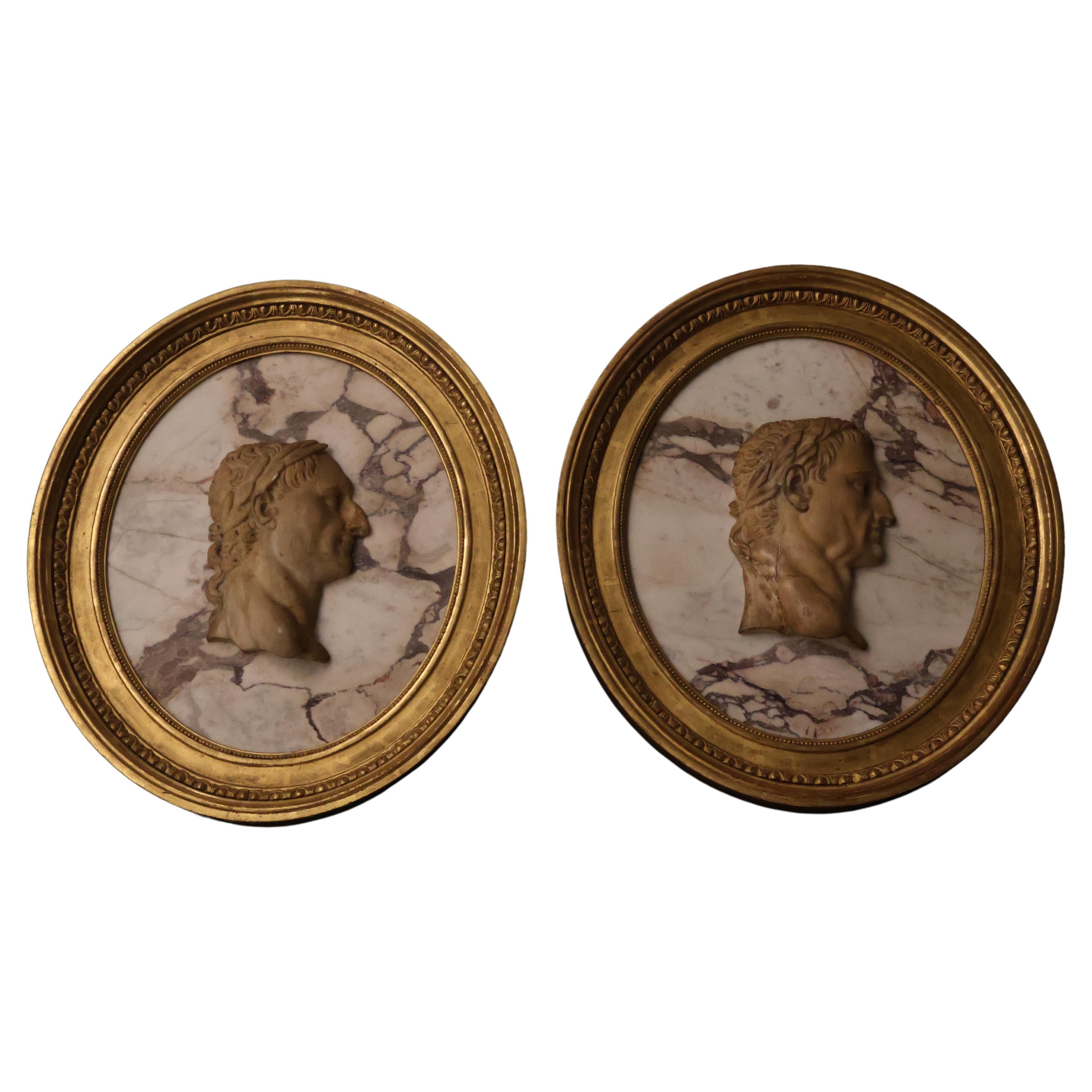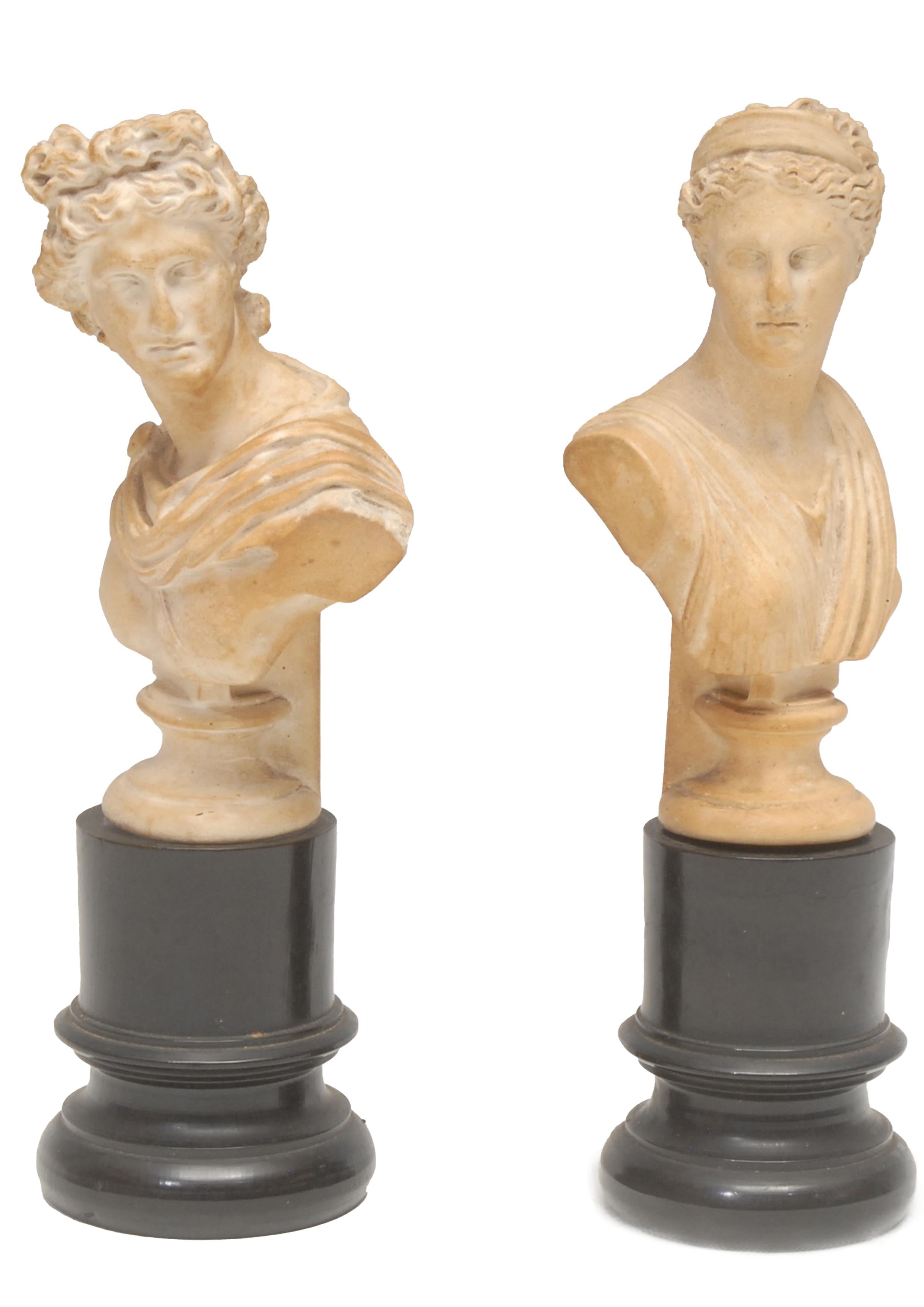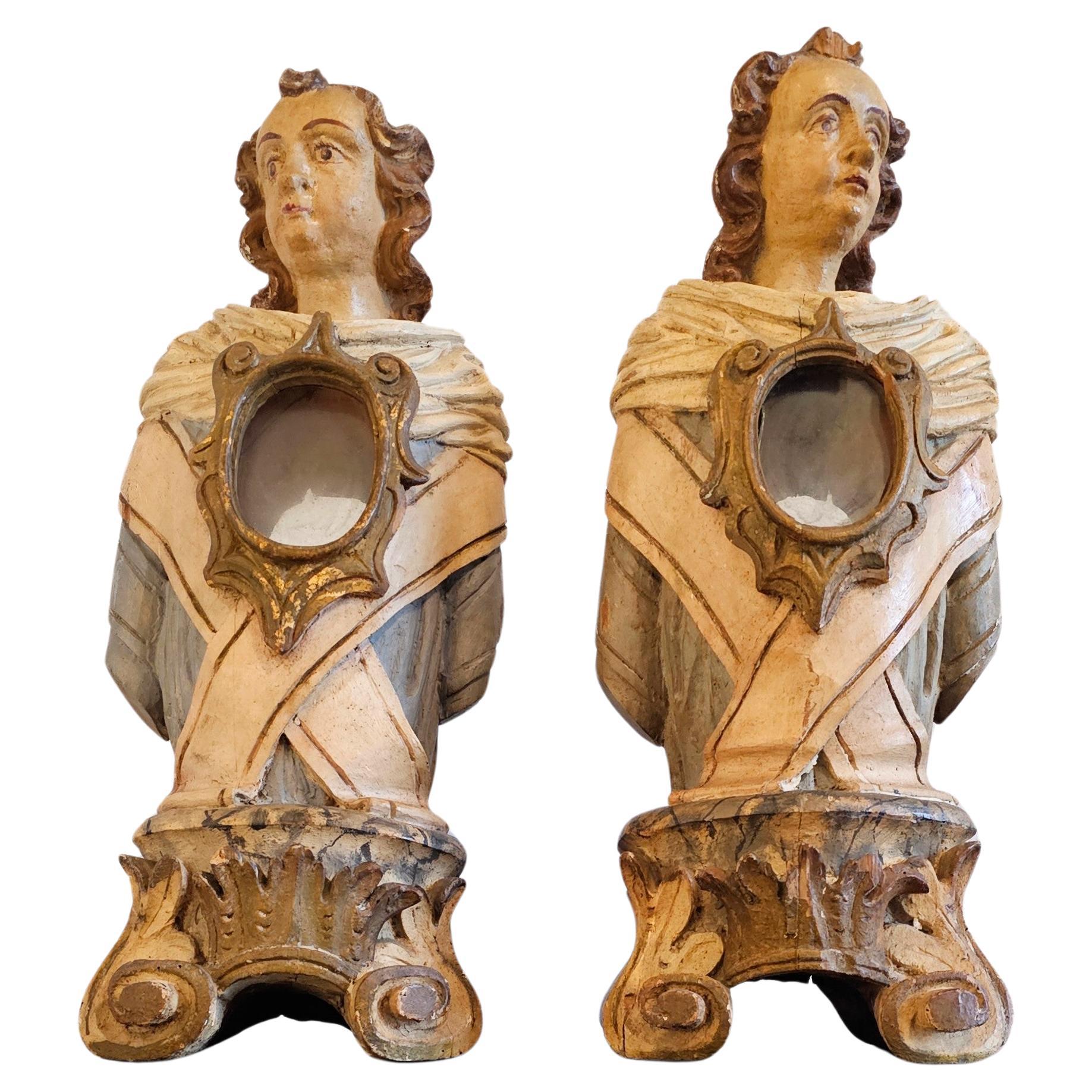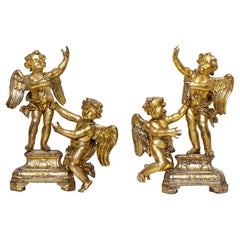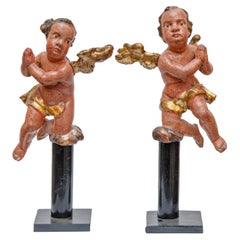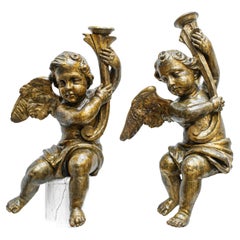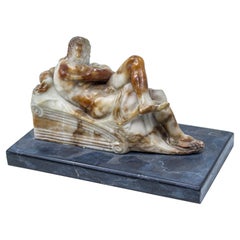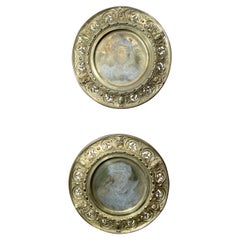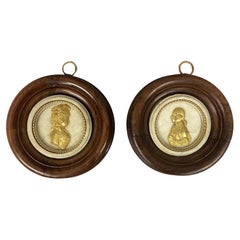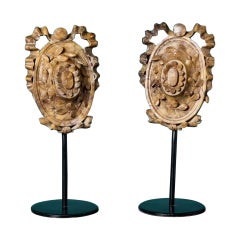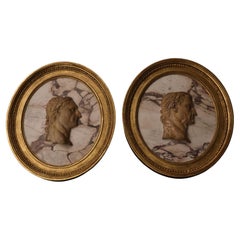Items Similar to 19th Century Pair of Desks with portraits of Petrarch and Leonardo Alabaster
Want more images or videos?
Request additional images or videos from the seller
1 of 16
19th Century Pair of Desks with portraits of Petrarch and Leonardo Alabaster
$2,152.62per set
£1,591.82per set
€1,800per set
CA$2,978.90per set
A$3,315.27per set
CHF 1,726.01per set
MX$40,035.46per set
NOK 21,645.76per set
SEK 20,445.78per set
DKK 13,710.02per set
About the Item
19th century
Pair of desks with portraits of Petrarch and Leonardo
(2) Alabaster, 34 and 35 cm diam
The pair of alabaster discs features a central cameo with the effigy of Petrarch and Leonardo, probably part of a larger series that featured illustrious characters from Italian history. On the openwork frame of Petrarch there are portraits of some characters who face each other, combined for centuries, as can be seen from the shapes of the garments that span several centuries: from the thirteenth century, in which men wear long-tipped bonnets, to the fifteenth century and Sixteenth century, the two characters at the top, in the seventeenth century, with wide collars, up to the eighteenth century.
Francesco Petrarca (1304-1374) embodies the figure of the humanist intellectual par excellence, entirely dedicated to the study of Latin conceived as the only form of expression worthy of a man of letters, so as to serve any form of written communication, including letters and the reflection on himself witnessed in the Secretum. A personality made more complex by obsessive perfectionism, which led him to a continuous and infinite editing of the work which he also flaunted to consider as minor and which instead ensured him an undying fame among posterity, the Canzoniere. But the only aspect fixed in the collective imagination is that of the lover who idolizes the places where his ideal love blossomed and where it remained hovering after the death of his earthly object. The dimension of the memory of an unconsummated love, made of contemplation and desire, capable of transfiguring the place of encounter or vision, the longing for an ideal beauty as a poetic inspiration are the themes that attract lovers of the Petrarchian myth. The typical representation of Petrarch, as well as part of his literary fortune, ends up by grasping an absolutely marginal and partly strongly deviant aspect of the public and sought-after image of the great man of letters.
Leonardo da Vinci was born in 1452 and died in Amboise in 1519). He personified the Renaissance genius that revolutionized both the visual arts and the history of thought and science. He presents himself with a letter that represents a kind of curriculum in which he describes his aptitudes as a civil engineer and builder of war machines to the Duke of Milan Lodovico Sforza, who welcomed him well. Here the pictorial masterpieces are born: the Virgin of the Rocks in the two versions of Paris and London and the exercise for the bronze equestrian monument to Francesco Sforza. In 1489-90 he prepared the decorations of the Castello Sforzesco in Milan for the wedding of Gian Galeazzo Sforza with Isabella of Aragon while, as a hydraulic engineer, he took care of the reclamation in the lower Lombardy region. In 1495 the fresco of the Cenacle begins in the church of Santa Maria delle Grazie. In 1499 Leonardo escaped from Milan because it was invaded by the troops of the French king Louis XII and took refuge in Mantua and Venice. In 1503 he was in Florence to fresco, together with Michelangelo, the large Council Hall in the Palazzo della Signoria. Leonardo is entrusted with the representation of the Battle of Anghiari which, however, he will not complete, due to his obsessive search for artistic techniques to be experimented or innovated. In 1513 the king of France Francis I invited him to Amboise. Leonardo will take care of projects for the celebrations and will continue with his hydrological projects for some rivers of France. In 1503 he was in Florence to fresco, together with Michelangelo, the large Council Hall in the Palazzo della Signoria. Leonardo is entrusted with the representation of the Battle of Anghiari which, however, he will not complete, due to his obsessive search for artistic techniques to be experimented or innovated. In 1513 the king of France Francis I invited him to Amboise. Leonardo will take care of projects for the celebrations and will continue with his hydrological projects for some rivers of France. In 1503 he was in Florence to fresco, together with Michelangelo, the large Council Hall in the Palazzo della Signoria. Leonardo is entrusted with the representation of the Battle of Anghiari which, however, he will not complete, due to his obsessive search for artistic techniques to be experimented or innovated. In 1513 the king of France Francis I invited him to Amboise. Leonardo will take care of projects for the celebrations and will continue with his hydrological projects for some rivers of France. In 1513 the king of France Francis I invited him to Amboise. Leonardo will take care of projects for the celebrations and will continue with his hydrological projects for some rivers of France. In 1513 the king of France Francis I invited him to Amboise. Leonardo will take care of projects for the celebrations and will continue with his hydrological projects for some rivers of France.
- Dimensions:Height: 13.78 in (35 cm)Diameter: 13.78 in (35 cm)
- Sold As:Set of 2
- Materials and Techniques:
- Place of Origin:
- Period:
- Date of Manufacture:19th Century
- Condition:Wear consistent with age and use.
- Seller Location:Milan, IT
- Reference Number:1stDibs: LU5918226540562
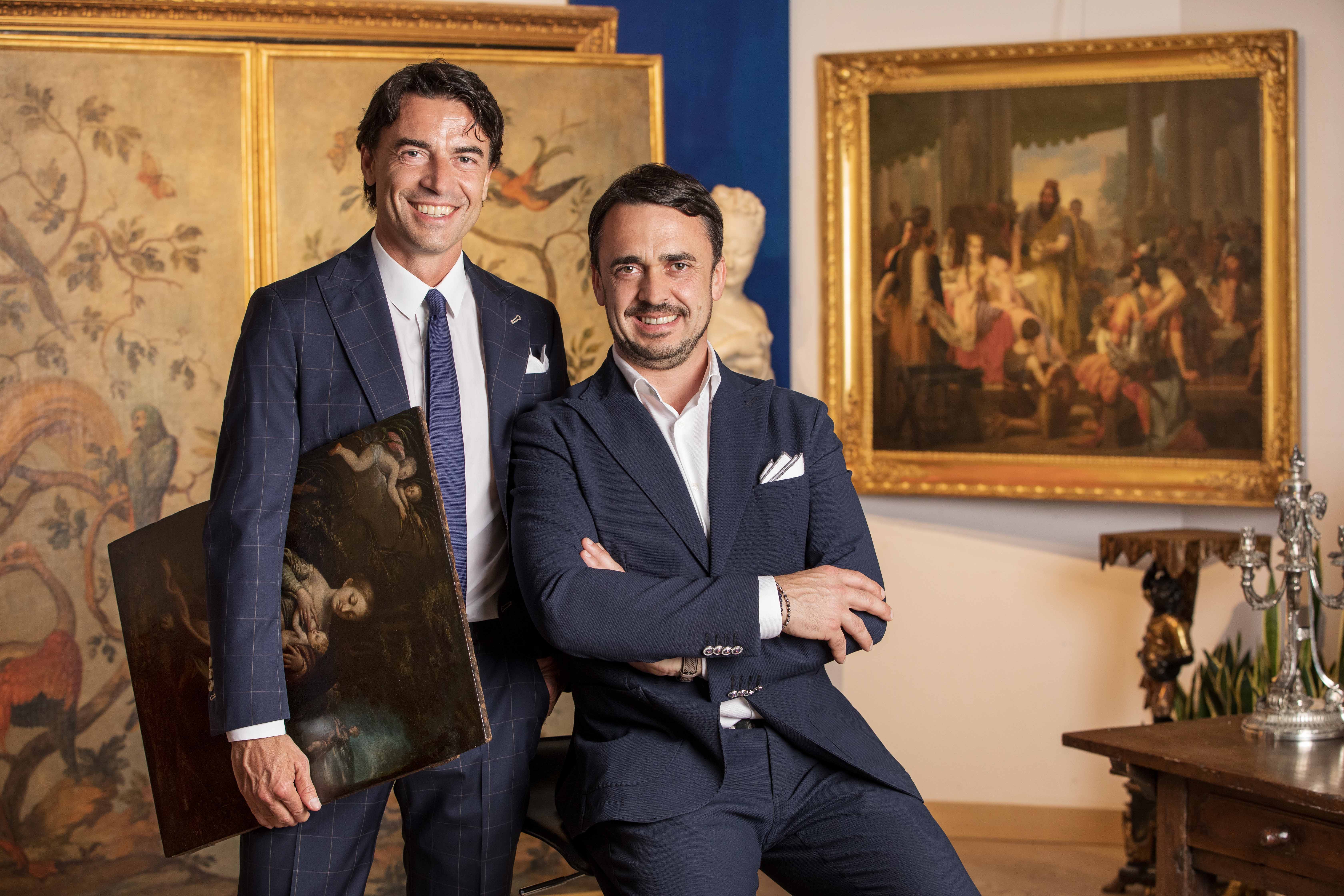
About the Seller
5.0
Vetted Professional Seller
Every seller passes strict standards for authenticity and reliability
Established in 2000
1stDibs seller since 2021
30 sales on 1stDibs
- ShippingRetrieving quote...Shipping from: Milan, Italy
- Return Policy
Authenticity Guarantee
In the unlikely event there’s an issue with an item’s authenticity, contact us within 1 year for a full refund. DetailsMoney-Back Guarantee
If your item is not as described, is damaged in transit, or does not arrive, contact us within 7 days for a full refund. Details24-Hour Cancellation
You have a 24-hour grace period in which to reconsider your purchase, with no questions asked.Vetted Professional Sellers
Our world-class sellers must adhere to strict standards for service and quality, maintaining the integrity of our listings.Price-Match Guarantee
If you find that a seller listed the same item for a lower price elsewhere, we’ll match it.Trusted Global Delivery
Our best-in-class carrier network provides specialized shipping options worldwide, including custom delivery.More From This Seller
View AllFirst Half of the 18th Century Putti Pair of Sculptures in Gilded Wood
Located in Milan, IT
First half of the 18th century, Lombardy
Putti
(2) gilded wood, H 88 cm
The work is distinguished by the high artistic quality and the remarkable executive care, as eviden...
Category
Antique Early 18th Century Italian Figurative Sculptures
Materials
Wood
18th century, Pair of angels
Located in Milan, IT
18th 18th Century
Pair of little angels
Polychrome wood, cm h 25
Category
Antique 18th Century and Earlier Italian Other Figurative Sculptures
Materials
Wood
$2,630 / set
Pair of candle-bearing angels, Carved and gilded wood, 18th century
Located in Milan, IT
18th 18th Century
Pair of candle-bearing angels
Carved and gilded wood, 28 x 71 cm
The item is in good condition
Category
Antique 18th Century Figurative Sculptures
Materials
Giltwood
18th Century Personification of the Day Alabaster Sculpture
By Michelangelo Buonarroti
Located in Milan, IT
18th century
Personification of the Day
Alabaster, cm 11.5 x 17.5 x 5
With base cm 14.5 x 20,8 x 11.7
Il Giorno is a marble sculpture (160x150 cm) that Michelangelo mad...
Category
Antique 18th Century Figurative Sculptures
Materials
Alabaster
19th Century Pair of Vases Porcelain Austrian Workshop
Located in Milan, IT
19th century, Bloch workshop
Pair of vases
(2) Porcelain, cm H. 36
The two porcelain vases, in the shape of an amphora, with handles, are to be associated with the Bloch wor...
Category
Antique 19th Century Austrian Vases
Materials
Porcelain
18th Century Pair of Inlays Various Types of Wood
Located in Milan, IT
Central-northern Italy, 18th century.
Pair of inlays.
(2) Various types of wood, briar, 25 x 38.5 cm.
Frame, 25 x 38 cm.
Very rare and meticu...
Category
Antique 18th Century Italian Decorative Art
Materials
Wood
You May Also Like
Pair Antique 19th Century English Etched Portraits in Brass
Located in New Orleans, LA
Pair antique 19th century English Etched Portraits in brass.
Category
Antique 19th Century English Decorative Art
Materials
Brass
Pair Of 19th Century Doré Bronze Portrait Medallions Mounted on Carrara Marble
Located in Bradenton, FL
Pair of 19th Century round French Royalty Doré bronze portrait medallions mounted on Carrara marble. Portraits are gold in color and trim and framed in 1.5" dark wood frame. Round br...
Category
Antique 19th Century French Empire Picture Frames
Materials
Marble, Bronze
Pair of Antique 19th Century Breccia Marble Appliqués
Located in Wormelow, Herefordshire
A pair of antique carved breccia marble appliqués dating to circa 1830.
Showcasing expertly carved floral and swags designs, this pair have been broug...
Category
Antique Early 19th Century French Baroque Mounted Objects
Materials
Marble, Breccia Marble
A Pair of Framed Marble Cameos of Roman Emperors
Located in Atlanta, GA
A Superb Pair of Breche Violette & Marble Cameos depicting Roman Emperors resting inside oval giltwood frame. France, circa 1860.
CW5028
Category
Antique 1860s French Empire Wall-mounted Sculptures
Materials
Marble
18th Century Italian Grand Tour Pair Of Classical Busts Apollo Belvedere & Diana
Located in Reading, Berkshire
Elegant Pair The Italian 19th Century Grand Tour Classical Greek God And Goddess Apollo And Diana Decorative Alabaster Busts For A Wonderful Library Desk
Depicting Apollo Belvedere ...
Category
Antique 18th Century Italian Grand Tour Busts
Materials
Marble
18th Century Italian Carved Painted Wood Reliquary Altar Figure Bust Pair
Located in Forney, TX
A remarkable pair of scarce large Italian Baroque period carved and painted wood church altar reliquary busts.
Born in Italy in the 18th century / possibly late 17th century, figural form, each hand carved from a single log, modeled as opposing figures, parcel gilt polychrome decorated, hollowed central cavity with original glazed glass relic viewing panel, rising on integral marbleized scroll foot base.
Dimensions: (each)
21.25" Tall, 8.5" Wide, 8" Deep;
16.25lbs Total
Condition Report:
Very good original unrestored antique condition with beautifully aged patina. Wear consistent with age and use, including scattered nicks, chips, and chippy paint losses. One glazed panel with losses to sides. Overall in great shape, strong, sturdy, stable, and structurally sound. Presents splendidly
We here at Lynx Hollow Antiques absolutely love decorating with religious antiques! From an antique altarpiece, tabernacle, reredos, shrine niche, baptismal font, crucifix, santo statue, icon, religious folk art, retablo, monastery table to church architectural elements...
Category
Antique 18th Century Italian Baroque Religious Items
Materials
Blown Glass, Wood
More Ways To Browse
Alabaster Figure
19th Century Italian Alabaster
19th Century Alabaster Sculpture
Civil War Desk
Antique Love Letter
Man Cameo
Antique Effigy
French Renaissance Desk
Italian Cameos Framed
Church Desk
King Louis Desk
Renaissance Cameo
19th Century Bronze Equestrian Sculptures
Council Desk
Italian Bronze Equestrian Sculptures
Lucite Art Stand
Montreal Used Office Furniture
Scandinavian Bronze Sculptures
